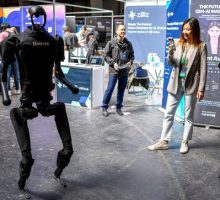Apple Explores Robotics in Search of Life Beyond the iPhone
2024/8/25

Apple is exploring a push into robotics — both to gain a foothold in consumers’ homes and add a new dimension to its product lineup. Also: Meta nears the launch of a cheaper Quest; Apple tries a new Vision Pro sales tactic; and the App Store chief is leaving as part of a reorganization.
Last week in Power On: Apple is playing the long game with a switch away from Qualcomm modems.
The Starters

When Apple Inc. executives have pondered what new products to sell, they realize they have a bit of a dilemma: The company’s devices are already woven into nearly every part of consumers’ lives
People get their information and entertainment through the screens of iPhones, iPads, Macs and Apple TV set-top boxes. AirPods and Beats headphones deliver audio to their ears. And the Apple Watch gives customers a view into their health and fitness. Apple is even trying to literally change the way people see the world through the Vision Pro.
The company can always improve those devices (making them smaller, boosting battery life or speeding up processors), but it’s much harder to find a groundbreaking new innovation.
Apple failed to create a new product category with its self-driving car project, which was shuttered earlier this year. But the effort did spark an intriguing question within the company: If Apple products can move around on their own, what new experiences could be created?
Though the dream of selling an autonomous car ultimately died, the concept was essentially a giant rolling robot. And the fundamental technology can be applied to other areas. Around 2020, Apple began exploring the idea of having other products move around via robotics — an effort that’s still very much alive today.
But Apple is still in the early stages of figuring out the best way to use robotics. The test case will be a tabletop device codenamed J595 that brings together a large, iPad-like display with cameras and a base that features a robotic actuator. That product likely will arrive around 2026 or 2027, followed by mobile robots and possibly even humanoid models in the next decade.
With robotics, Apple believes it can solve a series of first-world problems:
- Your device is only useful if you can reach it. There are many occasions when you might like to use your computer but it isn’t nearby — or your hands are otherwise occupied. Maybe you left a device in your home office, but now you’re in the kitchen or living room and need it.
- You may want to take photos of things or launch a videoconferencing session, but you’re not holding a device or sitting directly in front of it.
- You might want to operate or check something in your home while being out of the house.

Attaching a robotic limb to the iPad, for instance, will potentially make the device more useful for videoconferencing or browsing the web for recipes. If you’re busy in the kitchen, it can swivel the screen around to face you. Someday, an Apple robot could go further. Apple has envisioned machines that can do household chores — like loading up a laundry machine or scrubbing down dirty plates — but that’s still so far in the future that the ideas don’t go beyond sketches on a whiteboard
Advances in artificial intelligence will also give the concept a boost. It’s clear that AI will be at the core of any robotic device in the future. But Apple can also apply its expertise in sensors, advanced silicon, hardware engineering and batteries, as well as its ability to map the spaces around devices.
Given all that, some people within Apple say it’s the perfect time to tackle robotics. And shutting down the car project, which had hundreds of engineers with experience in self-driving technology and robotic systems, helped free up staff and resources to pursue the idea aggressively. But others say it’s an exaggeration to describe robotics as some major new frontier that the company will be able to conquer.
A successful robotics device could help Apple finally break into the smart home — an area where it’s trailed behind Amazon.com Inc. and Alphabet Inc.’s Google. The tabletop device might be the thing that finally helps Apple home devices stand out.
The work on robots is led by Kevin Lynch, Apple’s vice president of technology, who previously ran the car team as well as watch software engineering. He reports to Apple’s AI chief and works alongside robotics teams within the hardware engineering division. Recently, Apple has hired top robotics experts from places like Technion in Israel.

One vital piece of the robotic work is the creation of a personality. While Siri is the digital assistant on Apple’s current devices, the company is working on another humanlike interface based on generative AI. It could run on the tabletop product and other future Apple robotics devices, I’m told.
To be sure, Apple and the rest of the robotics industry still have a long way to go. Let’s be honest: The robots on the market today are costly, not very smart and lacking in capabilities. There’s also the reality that most consumers are probably not ready to live like The Jetsons. There are many technical problems to overcome, including having hardware that can successfully roam through cluttered spaces and navigate buildings with multiple floors.
For now, the technology is going to be incredibly expensive for both Apple to build and for consumers to buy. The company is also going to need more talent, including many more engineers, to bring something truly meaningful to market. Apple knows this as well. A few years ago, its M&A chief, Adrian Perica, met with robotics firm Boston Dynamics about a potential acquisition. (Hyundai Motor Group later bought a majority stake in the business, famous for its robot dogs, in 2021.)
People involved in Apple’s robotics work believe there is a lot of promise, though there’s also plenty of reason to be skeptical. The car project failed, and the company has struggled in other areas, such as the development of augmented reality spectacles. It’s not clear how committed Apple is to actually bringing something to market. But if the company truly wants to find another way into consumers’ lives, robotics might make the most sense.
The Bench

Meta readies a cheaper Quest and AR glasses prototype. Apple’s Sept. 10 event to launch the iPhone 16 won’t be the only hardware debut next month. Meta Platforms Inc., the iPhone maker’s biggest rival in wearable devices, will be holding its Connect conference on Sept. 25 and Sept. 26. Though much of Meta’s presentation will focus on artificial intelligence features, it will also include new mixed-reality headsets and smart glasses, I’m told.
The biggest debut will a preview of Meta’s future augmented reality glasses. The company will show off a prototype called Orion that it hopes will be the basis for an eventual AR glasses product. Meta executives have been teasing this preview for weeks, and it should show their vision for the future of computing. Creating true AR glasses — something lightweight that consumers can wear all day — is no easy task. Apple has struggled with its own efforts, and now all signs point to Meta being ahead.
Meta already sells non-AR smart glasses through a partnership with Ray-Ban, and that product has been surprisingly popular. At the Connect event, Meta plans to show off new AI-driven software features for those glasses, as well as updated styles and colors. It also will expand sales of the device to additional areas. By next year, Meta plans to incorporate an AR-like display into smart glasses, but it won’t be as ambitious as the Orion prototype. I would expect both these products to eventually converge once AR technology advances enough.
Meta also will unveil a new version of its mixed-reality headset, possibly with the name Quest 3S (multiple monikers have been discussed internally). This will be a new entry-level device meant to bring more people into the Meta ecosystem. While the Quest 3 costs $500, Meta has discussed pricing this budget-minded version at $300 or $400. The company has considered getting the cost down by selling the controllers separately, but at least some models of the new hardware will include them in the box.
A lower-end Quest would give Meta an even bigger price advantage over Apple. With the latest device, it’s possible that Meta will have a headset that costs a 10th of the $3,500 Vision Pro. That’s just too big a difference to ignore, regardless of how good the Vision Pro is. If Apple wants to make headway in the mixed-reality space, it will have to speed up efforts to bring down its price.

Apple tries a new tactic to get shoppers interested in the Vision Pro. Since launching the Vision Pro in US retail stores in February, Apple has relied heavily on 30-minute demos to market the device. The approach makes sense: It’s an impressive piece of technology that customers only truly appreciate by experiencing it (even if they still balk at the price). Now, Apple is betting further on that idea. It’s rolling out a new “Today at Apple” session in stores that lets retail employees talk up the Vision Pro to shoppers and encourage them to take a demo. This comes weeks after it revamped the demo experience to let customers see their own media in 3D.
Roster Changes

Phil Schiller reorganizes the App Store amid global scrutiny. The App Store may be one of Apple’s most lucrative businesses, but it’s also notoriously difficult to deal with. Software developers and Apple rivals have long complained about the platform’s rules and terms, including its commissions of up to 30%. That’s why some regulators are dead-set on reforming the business and leveling the playing field. That includes allowing app developers to distribute iPhone software outside the App Store. For a while now, Apple has done everything in its power to resist this change, but it now has no choice but to comply (more or less) with new laws such as the EU’s Digital Markets Act.
With this shift underway, Apple veteran Phil Schiller is splitting his App Store team into two: One will oversee the existing App Store, and another will handle the new alternative ways that apps are distributed. As part of that change, there is a roster move: Matt Fischer, the longtime vice president in charge of the App Store, is leaving Apple in October. Carson Oliver and Ann Thai will lead the two new groups.
The Schedule

Sept. 10: Apple’s iPhone 16 launch. Apple’s September product launches are typically the first Tuesday or Wednesday after Labor Day, and it looks like this year will follow that same pattern. The company has wrapped up filming of its iPhone 16 launch video and is planning to host an event at its campus on Tuesday, Sept. 10. Sticking to the script of the past few years, Apple will air the keynote video in the Steve Jobs Theater and allow attendees to check out the new iPhones and other hardware afterward. Of course, the presentation will also be streamed online. The new iPhones will hit stores 10 days later, beginning on Friday, Sept. 20.
Source:Apple Plans Tabletop Robot, While Exploring Mobile Bots and Humanoid Machines – Bloomberg

